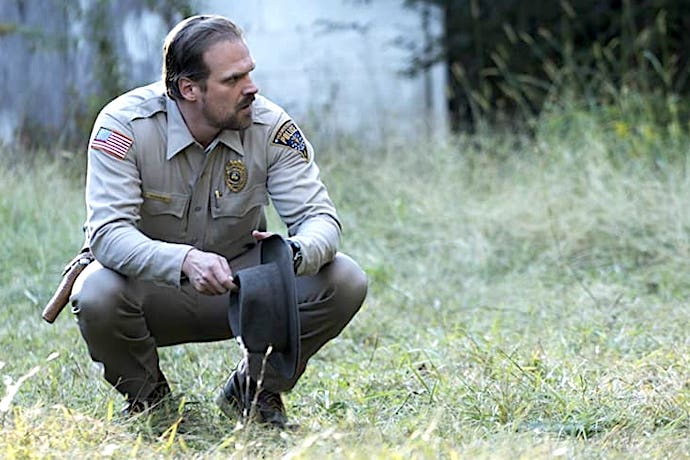Screen Rant reporter Cathal Gunning has a beef with Stranger Things 3—and understandably so. In a regressive misstep the series turned Hopper the “vulnerable and realistically aging sheriff” into “a typical invulnerable ‘80s action hero.” In other words, Hop is transforming fully into Indiana Jones, the character he was only somewhat inspired by. It’s no secret that the police chief’s hat and gruff personality are nods to Harrison Ford’s Jones. Actor David Harbour has even promised “Indiana Jones-type action” in Stranger Things 4. This doesn’t mesh well with Gunning’s optimistic theory that Hop’s much-anticipated dark backstory will again show his vulnerable side. Whatever The Duffer Brothers have in store for Hopper, one thing’s for sure— there’s a lot at stake.
In referencing both The Exorcist and the Indiana Jones trilogy (1981-1989) Stranger Things has ample opportunity to critique the gender/sexuality politics extolled by the Christian Right. In addition to reflecting on Reagan-era homophobia, the series has also been widely interpreted as commenting on Trump(ism)—prompting denials on the part of the auteurs. These readings, however, are bolstered by Harbour’s pro-inclusivity (read: anti-Trump protest) speech at the 2017 Screen Actors Guild Awards. Yet, flying in the face of the series’ feminist and LGBTQ affirmative sentiments, Harbour’s Police Chief Hopper is at risk of mutating into Indiana Jones, a pop culture icon critics have long associated with Christian “family values.”
Indiana Jones: Christian Reaganite individualist
Shortly after its release Frank P. Tomasulo scathingly criticized Raiders of the Lost Ark (1981) for sounding the Moral Majority’s agenda. Take, for instance, Jones’s choice not to rescue Marion Ravenwood when realizing that her emancipation would jeopardize his/(America’s) quest for the Ark of the Covenant. As Tomasulo aptly observes, like with the Christian Right, in this scene: “God and Country take precedence over women’s ‘liberation.’”
The trilogy’s rampant sexism is embedded in narratives that extoll Christian nationalism and patriarchy. In Raiders, Jones, a gravedigger and Reaganite individualist, finds himself in a race with Nazis to discover the Ark of the Covenant. (Jones predictably emerges victorious but is disappointed when government bureaucrats decide to put the Ark in storage. His protests, in Tomasulo’s reading, echo the Moral Majority’s claim that Christianity has been removed from the political/public sphere).
As the story unfolds viewers watch the dramatic transformation of Jones’s attitude towards the Ark. At the onset he dismisses the idea that it might possess supernatural power as mere superstition. Witnessing the apocalyptic massacre of Nazis, however, places Jones “in the contemporary religious context of the ‘born again’ believer.” The conversion experience trope is revisited and further developed when, in Indiana Jones and The Last Crusade (1989), the archeologist must take a literal leap of faith to reach the cave that houses the Holy Grail.
Susan Aronstein commented on the significance of the The Last Crusade’s 1989 release date that coincided with Reagan’s waning presidency, wounded by the Iran-Contra scandal and nearing its end. The trilogy’s conclusion finds Jones seeking the Holy Grail to save his father/nation. In a sequence that rewrites the opening of Raiders, Jones must navigate through a boobytrapped enclosure, not with might and luck, but as a believing and well versed Christian Arthurian Knight.
The narrative revolves around Jones’s reunion with his father, Jones Sr., a representative of American tradition, wisdom and knowledge—who is juxtaposed with book-burning Nazis. The rescue of Jones Sr., then, is a call for the nation’s restoration of family values. In the film’s logic, Aronstein writes: “America has failed because it has lost its religious and familial (read: patriarchal) values, and its strength will be recovered only in an individual rediscovery of these traditions and a return to both transcendent and human fathers.”
The son’s rescue of a father figure was a standard plot device of Reagan-era blockbusters. Susan Jeffords considers The Last Crusade alongside other franchises including Back to the Future (1985-1990) and Rambo (1982-1988). These series, and a host of other films, reflected cultural and political desires to restore not only “family values” but also a post-Vietnam white masculinity. By pitting Jones against Nazis, Steven Spielberg invited viewers to forget the Vietnam War and celebrate an earlier U.S. military triumph that, in the film’s fiction, depended on Christian artifacts.
Katherine Biber describes this as part of “a large-scale attempt to rewrite history through a process of ‘forgetting’ the past and replacing it with an assortment of ‘facts’ that seek to place America—and American men specifically—at the centre of the world.” The philandering Jones enlivens developing countries with “a more grandiose, exciting, and dangerous quality.” In short, the archaeologist is engaged in a project of doing masculinity on a global stage. The Christian (nationalism)/heteropatriarchy that Jones embodied was, in a very literal sense, globalized both inside and outside his fictional world.
Here we might venture to consider the resonance between Jones’ globetrotting adventures and the endeavors of the Christian ex-gay movement that strove to globalize patriarchy. Before closing its doors, Exodus International, the largest umbrella organization of the ex-gay movement, gave the Christian Right access to the global stage with a presence in over 150 countries. Christine M. Robinson and Sue E. Spivey relay how the movement’s attempts to change men’s sexual orientation were coupled with pressures for participants to conform to gender norms. Therapy programs encouraged men to do manual labor and play sports as well as marry and dominate women. One myth leaders propagated was the idea that homosexuality could be linked to parenting—overbearing mothers and missing fathers. Fathers’ performance of acceptable masculinity, however, could prevent sons from developing same-sex desires.
The Last Crusade and the 2008 reboot Indiana Jones and the Kingdom of The Crystal Skull offer father-son stories steeped in mid 20th century heterosexism in which fathers model heteronormative masculinity for their sons. In The Crystal Skull Jones is reunited with Ravenwood and fights Cold War Soviets with his son Henry Jones III. The narrative concludes with the adult son attending his parents’ chapel wedding. In short, the reboot brings 80s nostalgia for the 1950s nuclear family into the 21st century. Spielberg’s 2008 reprise is arguably just as (if not more) preoccupied with family values as the 80s trilogy was.
Eight years later, in 2016, Trump’s MAGA campaign and election mainstreamed a similar longing for a (Christian) patriarchal pastime—and opened an era for the ex-gay movement to quietly resurface. In the same year, Netflix released the first installment of Stranger Things—a series that pays homage to 80s blockbusters while simultaneously critiquing their latent sexist and homophobic sentiments.
Leave the hat, take the vulnerability
Tracey Mollet examines the tension residing in the Stranger Things endeavor of holding discriminatory 80s films in adulation while advocating for inclusivity. Hopper’s proximity to the Indiana Jones franchise offers a case in point. On the one hand, as Mollet notes, despite wearing an Indiana-inspired hat, the vulnerable police chief is an example of how the series presents “us with alternative forms of masculinity” as David Harbour’s Hopper dramatically rewrites Harrison Ford’s Jones.
For one, there’s a sharp, let’s say, corporeal contrast between the two. Hop is an aging, mildly obese man struggling with substance abuse while Jones is relatively younger, leaner and (usually) sober. Spielberg, as noted, positioned Jones in a pre-Vietnam America. The Duffer Brothers, however, hint that Hop fought in the war (recall the box marked “Vietnam” under the police chief’s cabin as well as his familiarity with PTSD). Finally, instead of traveling the world as a diplomat of white Christian hetero masculinity, Hop (at least before winding up in a Russian prison at the end of Stranger Things 3) is domestically bound to a small rural Midwestern town. Rather than engage in (hetero)(imperial)(con)quests overseas, the police chief interrogates 80s constructs of masculinity and acts as an LGBTQ ally.
Whereas Jones is a signifier of heteropatriarchy, Hop’s central role is to defend and parent the queer-coded child/teen protagonists as part of season two’s project of “degendering or queering” modes of parenting. In one scene he affectionately compliments El—his soon-to-be adopted androgynous daughter—for her “bitchin” punk make-over. Lucy Baker and Amanda Howell note that here, the police chief is re-articulating his previous domineering efforts to keep El hidden, under lock and key, from government authorities: “Hopper re-evaluates his stance of patriarchal control, becoming in the process a positive example of parental adaptability and flexibility in an uncertain world.”
Not surprisingly, then, Hop, stands apart from the antagonistic (read: homophobic) fathers—Lonnie Byers and Neil Hargrove. Lonnie, the audience learns, used to call his son Will “queer.” And in a disturbing scene Neil strikes his son Billy calling him a “faggot.” Hop is not only accepting of the young protagonists but also aides them in fighting the monster, or rather the monstrosity of homophobia (Daniel Reynolds writes: “Homophobia Is the Real Monster in Stranger Things.”)
The first two seasons portrayed Hop as a complicated individual scarred by the loss of his biological daughter, while Stranger Things 3, however, delivers a one-dimensional action hero. Previously we watched Hop offer detective skills and emotional support all while struggling with depression, substance abuse and flashbacks. But, in the most recent installment Hop adopts a brute persona and offers little more than physical combat with a Terminator-inspired villain. One hopes that Harbour’s promise for “Indiana Jones-type action” in Stranger Things 4 is an exaggeration as that was actually the fatal flaw of the third installment.
The Netflix series has ventured very far from its critique of the Indiana Jones franchise that’s inextricably marred with xenophobia and Christian heteropatriarchy. Spielberg’s tone-deaf decision to executive produce a fifth Indiana Jones installment—release date scheduled for July 2022—demands of Stranger Things nothing short of a radical indictment. The most obvious, and often noted, nod the series makes to Indiana Jones is when Hop goes back for his hat. Along with a backstory that restores Hop’s emotional depth, The Duffer Brothers might consider giving us a scene where Hop, well—just leaves the hat behind.





